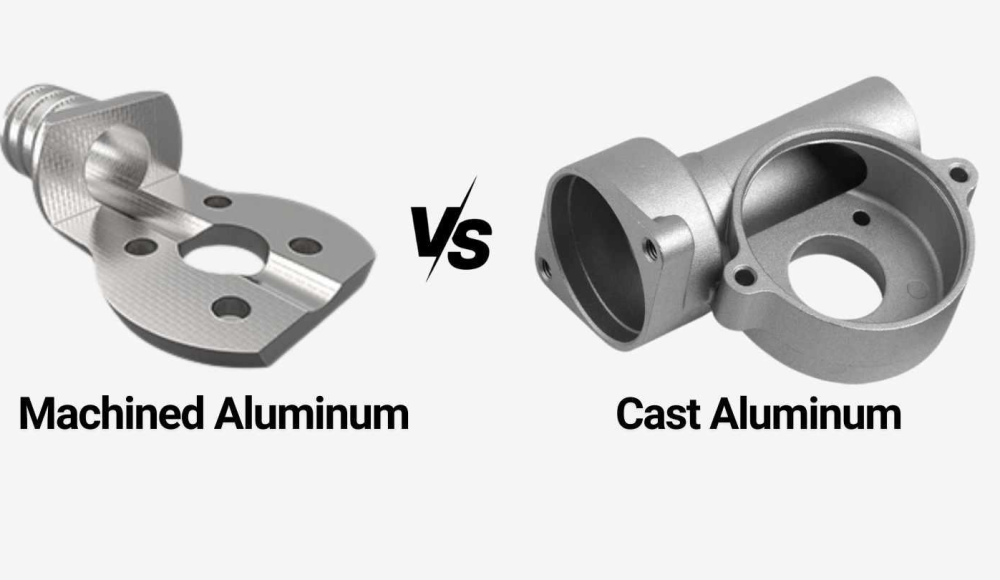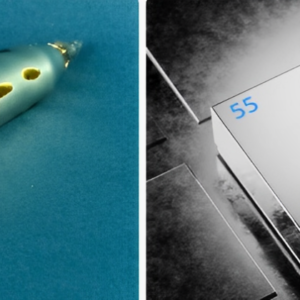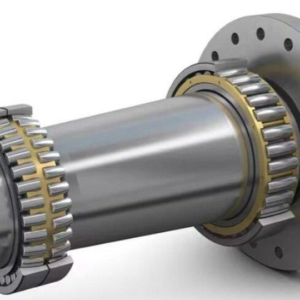Алуминий е един от най -широко използваните метали в съвременното производство, ценен за лекия си тегло, устойчивост на корозия, и отлични механични свойства. При производството на алуминиеви части, Обикновено се използват два основни метода - родителство и обработка. Но как те сравняват, и кой е най -подходящ за вашите специфични нужди?
Тази статия ще изследва разликите между Aluminium от CAST и обработен алуминий, техните предимства, недостатъци, и факторите, които трябва да се вземат предвид при избора на правилния метод за вашия проект.
Въведение
Известността на алуминий в индустрии като аерокосмическото, автомобилен, електроника, и строителството произтича от неговите уникални свойства. Изборът между части за леене и обработка на алуминиеви части зависи от фактори като сложност на дизайна, обем на производството, Изисквания за прецизност, и съображения за разходите.
Какво е обработено алуминий?
Определение и процес
Обработените алуминиеви части се създават чрез отстраняване на материал от плътна блок алуминий с помощта на режещи инструменти, контролирани от компютърно числово управление (ЦПУ) машини. Този изваждащ производствен процес позволява висока точност и е идеален за производство на сложни геометрии със тесни допустими отклонения.
Общи техники за обработка
- CNC фрезоване: Включва въртящи се инструменти за рязане за премахване на материал от детайла, Активиране на създаването на сложни форми и функции.
- CNC струговане: Детайлът се завърта, докато стационарен инструмент за рязане го оформя, който обикновено се използва за производство на цилиндрични части.
- Пробиване: Използва въртящи се свредла, за да създаде прецизни дупки в алуминиевия детайл.
- Смилане: Използва абразивни колела за постигане на фини повърхностни облицовки и прецизни размери.
Индустрии, които използват обработен алуминий
- Космонавтика: Компоненти като структурни части и корпуси на въздухоплавателни средства.
- Автомобилна: Части за двигател, радиатори, и компоненти на окачването.
- медицински: Хирургически инструменти и протезни устройства.
- електроника: Компютърни обвивки и прецизни конектори.
Обработката е предпочитана в приложения, изискващи висока точност, сила, и отлични повърхностни облицовки.
Какво е Aly Aluminium?
Определение и процес
Отливките алуминиеви части се произвеждат чрез изливане на разтопен алуминий във форми, където се втвърдява в желаната форма. Този процес е подходящ за създаване на сложни геометрии и е рентабилен за производствени работи с голям обем.
Общи методи за кастинг
Постоянно леене в калъп
- Леене под налягане: Разтопеният алуминий се инжектира под високо налягане в стоманени форми, което позволява бързо производство на точни части.
- Вакуумно леене под налягане: Вакуумът подпомага привличането на разтопен алуминий във формата, Намаляване на захващането на въздуха и подобряване на качеството на части.
- Инвестиционно леене: Използва восъчни шарки за създаване на форми за производство на сложни и подробни компоненти.
Разхождащо се леене на плесен
- Леене на пясък: Използва форми на базата на пясък, които се унищожават след всяка употреба, което го прави подходящ за големи части и по -ниски обем на производство.
- Изгубен восък леене: Включва създаване на восък модел, покриване с огнеупорен материал, за да се образува плесен, След това разтопяване на восъка и излива в разтопен алуминий.
Индустрии, които използват Aluminium Aluminium
Автомобилна: Двигателни блокове, случаи на предаване, и колела.
Строителство: Архитектурни компоненти и структурни опори.
Уреди: Части за печки, перални машини, и кухненско оборудване.
Кастингът е изгоден за производството на сложни форми и е рентабилен за масово производство.
Ключови разлики между обработения и отливателния алуминий
| Категория | Обработен алуминий | Лят алуминий |
| Типове материали | Общите сплави включват 6061, 7075, и 2024, известни със своята сила и обработка. | Обикновено използва сплави като A356, A380, и A390, избрани за техните свойства на кастинг и механични характеристики. |
| Скорост на производство | Подходящ за обем на производство с нисък до среден; Настройката е бърза, Но времето за обработка се увеличава със сложността на части. | Ефективни за производство с голям обем, след като се създадат форми; Първоначалното производство на плесен може да отнеме много време и скъпо. |
| Повърхностно покритие | Постига гладки и адаптивни облицовки директно от процеса на обработка; Допълнителното полиране може да подобри външния вид. | Може да проявява повърхностни несъвършенства; често изисква след обработка като обработка или полиране за постигане на желания завършек. |
| Прецизност & Допустими отклонения | Способни да постигнат строги допустими отклонения, което го прави идеален за компоненти, където прецизността е от решаващо значение. | Като цяло предлага по -ниска точност поради фактори като износване на плесен и метално свиване по време на охлаждане; подходящи за части, където точните допустими отклонения са по -малко критични. |
| Сила & Издръжливост | Обработените части поддържат присъщата сила на материала и не са без вътрешни дефекти, осигуряване на висока надеждност. | Отливите части могат да съдържат порьозност или включвания, потенциално намаляване на силата; обаче, те са адекватни за много приложения. |
| Съображения за разходите | По -висока цена на единица поради времето за обработка и износването на инструмента; Няма нужда от скъпи форми, което го прави рентабилен за малки партиди или прототипи. | По -ниска цена на единица в масовото производство, но първоначалната инвестиция в създаването на плесен е съществена; рентабилни за големи количества. |
| Най-добрите приложения | Идеален за аерокосмически компоненти, медицински изделия, и прецизни инструменти, при които високата точност и целостта на материала са от първостепенно значение. | Подходящ за автомобилни части, потребителски стоки, и структурни компоненти, при които сложните форми и ефективността на разходите са приоритизирани през изключителна точност. |
Плюсове и минуси на обработен алуминий
плюсове
- Висока точност: Обработката на ЦПУ позволява точни размери и тесни допустими отклонения, от съществено значение за критичните приложения.
- Превъзходно покритие на повърхността: Произвежда части с отлично качество на повърхността, Намаляване на необходимостта от допълнителни процеси на довършителни работи.
- Материална цялост: Поддържа еднакви свойства на материала без вътрешни дефекти, Осигуряване на последователно изпълнение.
- Гъвкавост: Тъй като не са необходими форми, Обработката на ЦПУ може лесно да побере модификации на дизайна и малки производствени писти.
- Широко избиране на материали: Разнообразие от алуминиеви сплави, включително оценки с висока якост като 7075, може да се използва за обработка.
минуси
- По -висока цена за големи производствени писти: Макар и чудесно за малки партиди, Обработката на ЦПУ става скъпа при мащабиране поради продължително време за производство и износване на инструмента.
- Материални отпадъци: Тъй като обработката на ЦПУ е изваждане, значително количество материал се отрязва, което води до по -високи материали в сравнение с леенето.
- Ограничена сложност на дизайна: Докато обработката на ЦПУ може да произвежда сложни форми, Някои изключително сложни геометрии (като вътрешни кухини) са по -подходящи за кастинг.
Плюсове и минуси на алуминия за отливане
плюсове
Рентабилен за масово производство: След като мухълът е направен, Кастингът дава възможност за производство с голям обем при ниска цена на единица.
Отличен за сложни форми: Алуминият алуминий може да постигне сложни геометрии, които биха били трудни или невъзможни за машина.
По -ниски материални отпадъци: Кастингът използва само необходимото количество разтопен алуминий, минимизиране на материалните отпадъци.
Добро съотношение сила към тегло: Алуминиевите компоненти са достатъчно силни за много приложения, докато остават леки.
минуси
По -ниска точност: Частите често изискват допълнителна обработка, за да отговарят на тесни допустими отклонения.
Повърхностни несъвършенства: Порьозност, свиване, и могат да възникнат груби текстури, Изискване на вторични довършителни процеси.
По-високи първоначални разходи: Създаването на форми за кастинг е скъпо и отнема много време, което го прави по -малко идеален за малки производствени писти или прототипиране.
Кога да изберете обработен алуминий срещу. Лят алуминий
| Изискване | Най -добър избор | Причина |
| Висока точност & Тесни допустими отклонения | Обработен алуминий | Обработката на ЦПУ постига превъзходна точност, което го прави идеален за аерокосмиче, медицински, и прецизно инженерство. |
| Комплексна геометрия & Сложни форми | Лят алуминий | Кастингът позволява изключително сложни дизайни, които биха били трудни за машини. |
| Малки производствени писти | Обработен алуминий | Няма нужда от скъпи форми; Обработката на ЦПУ е рентабилна за проекти с нисък обем. |
| Мащабно производство | Лят алуминий | Кастингът е по-рентабилен за производството с голям обем. |
| Силен, Части с висока производителност | Обработен алуминий | Обработката запазва целостта на материала, произвеждайки по -силни и по -надеждни компоненти. |
| Ефективност на разходите за прости части | Лят алуминий | Кастингът е по -икономичен за производство на основни компоненти с минимална обработка. |
Заключение
Както обработеният алуминий, така и алуминиевият алуминий имат своето място в производството. Обработката на ЦПУ превъзхожда прецизно, сила, и качество на повърхността, което го прави идеален за високоефективни приложения. От друга страна, Кастингът е изборът за производство на големи количества сложни части на по-ниска цена.
Изборът на правилния метод зависи от изискванията на вашия проект, бюджет, и обем на производството. Ако имате нужда от висока точност и сила, обработката е по -добрият вариант. Ако сложността на разходите и дизайна са по -важни, Кастингът е пътят.
Ако не сте сигурни кой процес най -добре отговаря на вашите нужди, Консултацията с експертен производител може да ви помогне да вземете правилното решение.
Научете повече & Вземете оферта
За повече информация относно Обработка на ЦПУ и леене на алуминий, Посетете:
🔗 Xometry - CNC обработка на услуги
🔗 Phb Corp - Die Casting обясни
🔗 LeClaire Manufacturing - Пясъчно леене срещу. Леене под налягане
Бихте ли искали да добавите допълнителни подробности или да промените конкретни раздели? 😊



